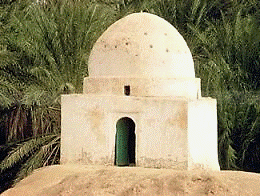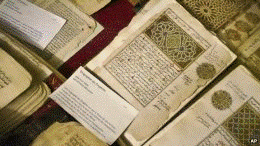Cross-posted from the Colorado Progressive Jewish News.
1. From Timbuctou to Tunis, marabout desecration

Marabout at Tozeur, in the Tunisian Sahara
In early times Timbuctou was a key transit point for the trans-Sahara caravan trade. It remains a key center of African Islam with an extraordinarily rich heritage of Sufi (Islamic mystics) shrines and written documents going back a thousand years. Its manuscript collection is acknowledged as one of the richest treasure troves of human culture anywhere.
One of the goals of the Islamic radicals that temporarily seized and held Timbuctou was to destroy as much of that heritage as possible, understood by Salafists with their stone-age concepts of Islam, as heretical. Countering such destructive activity has become a pretext for big power intervention, be it the United States in Afghanistan or France in Mali (although both countries have more significant, ulterior motives).
The Salafist militias radicals sought to snuff out Timbuctou’s rich regional Islamic heritage – destroying mausoleums (called marabouts [i]), purging Sufi holy men and destroying as much of the city’s precious manuscript collection as possible. In the short time that they ruled Timbuctou, the Islamic militants instituted a typical regime of Wahhabist-like Sharia law with its usual retrograde practices (the subjugation of women, outlawing singing and dancing, stoning women to death for violating Salafist versions of sexual misconduct, i.e. the usual Taliban-like/Saudi-like nonsense).
Fortunately, much of Timbuctou’s manuscript heritage was saved, hidden away from the Salafist inquisitors. But much damage was still done. During the months Salafist militias ruled more than 300 of the town’s marabout shrines were destroyed. Islamic radicals also were able to burn two buildings to the ground housing extensive leather-bound manuscript collections, some dating back to the 13th century. Considered not merely an attack on African history and culture, the Salafist purge of Sufi documents has been described as “an assault on world heritage comparable with the demolition of the Buddha’s of Bamiyan in by the Taliban in 2001” – not an unfair comparison.
2. At least 40 Tunisian marabouts desecrated; transitional government seems unconcerned.

Timbuktu Sufi manuscripts
Defended by the Ennahda, their actions suggest that Tunisia’s Salafists are little more than the brownshirts of the Arab Spring. While publicly criticized by the U.S. State Dept and media, still the United States has a long and sordid history of allying itself under certain circumstances with Islamic fundamentalism. During the Cold War the U.S. sought alliances with Islamic fundamentalists to counter secular Arab Nationalism. The policies of Islamic fundamentalism – be it Ennahdha or the Salafists in Tunisia, or the Moslem brotherhood in Egypt – dovetail nicely with U.S. sponsored neoliberal capitalism. In the same veins, Islamic regimes partner with the U.S. military in its strategic goals – be it in Pakistan, Saudi Arabia, or now it seems, in Tunisia. In Tunisia, the main goal of the Salafists is freeze the radical possibilities of the Arab Spring in its tracks, to help the United States and its regional allies to “manage” the region-wide upsurge and to prevent the establishment of broad-based coalitions, in Tunisian and eleswhere, that could lead the region on a path of sorely needed structural changes.
In Tunisia, besides targeting the country’s media, women’s rights, trade unions – virtually anything that “reeks of democracy” – desecrating the few remaining Jewish cemeteries and trying to hijack the curriculum of the Tunisian university system with their own medieval versions of Islam, Tunisian Salafists have been especially intolerant to the country’s own unique tolerant Islamic heritage which extends back nearly 1,500 years.
In January of this year, a marabout in Sidi Bou Said, one of Tunisia’s most famous, was trashed and burned in an arson attack.[ii] Tunisia’s president, Moncef Marzouki, condemned the Sidi Bou Said attack as a “criminal act,” arsonists as “trying to undermine the country’s culture in its historic dimension.” Nor was the Sidi Bou Said arson the first incident of its kind. The Sidi Bou Said marabout trashing was serious enough to draw worldwide attention. But it was hardly the first incident of its kind. Marabouts all over Tunisia – more than 40 of them – had been attacked and destroyed in the months prior to January, 2013. While not on the scale of Mali, Tunisian manuscripts and other cultural jewels, again like Mali, some dating back nearly 1,000 years have been destroyed. Despite Marzouki’s outrage, very few of the marabout-trashing perpetrators have been tracked down or arrested by the Tunisian authorities, suggesting that protecting this part of the country’s national heritage is a low priority.
Sidi Bou Said is something akin to the “Aspen” of Tunisia – a lovely town north of Tunis sitting on a hillside overlooking the Mediterranean and one of the country’s primo tourist sites. There is a strong Salafist–Islamic fundamentalist presence in the area, which is also a stronghold for the Ennahda party. The day before, five ultra-conservative Muslims were arrested, charged with having burnt down another marabout in the Tunis region.
Targeting marabouts has emerged as an integral part of the Salafist revival in Tunisia, one tolerated by, if not coordinated with the goals of, Tunisia’s ruling Ennahha Party.[iii] Salafist elements in Tunisia, with their stone-aged, factional vision of Islam, consider such shrines, the veneration of holy shrines and ascetics as “un-Islamic.”
Present-day Tunisian Salafist opposition (much of it emanating from Saudi-trained Wahhabist imams) to the marabouts is based upon their narrow vision of the Islamic religion that charges the marabout system as being polytheistic. The more mystical Sufi tendency, which helped spread Islam, not only to Africa, but to as far east as Indonesia, is seen as nothing short of heresy, as is all of Shi’ite Islam and it is mercilessly attacked.
3. Rich history of Tunisian (and North African) marabouts
It is something of a half truth to claim that Islam came to North Africa “by the sword” alone. Military conquest only began the process of conversion. If Christianity has its Jesuits, Franciscans and the like who tried to compensate for Spanish (and other European) military colonial brutality with “good works,” Islam has its Sufi mystics, those wandering aesthetics whose connection to local populations was much stronger than the generals’. Hermits, scholars, their example was critical in the eventual conversion of many in North Africa. To honor them, locals built what the media calls “mausoleums” but what are better known through North Africa as “marabouts.”
The Sufi mystics so-honored with marabout shrines were ultimately much more effective than the Christian missionaries that preceded them in North Africa in the 3rd to 7th centuries. The latter’s influence rarely extended beyond the Magreb’s urban trading centers on the Mediterranean. To the contrary, Sufi influence, overtime – it took several centuries – struck deep into the North African countryside and desert in a way that the Christianity of earlier centuries was never was able to penetrate. It is through them in large measure, that Islam spread first to North Africa and then across the Sahara to Mauritania, Senegal, Mali, Niger, Chad and Northern Nigeria.
While many marabouts are distinctly Moslem holy places dedicated to the memory of Islamic Sufi mystics (like the one in Sidi Bou Said, Tunisia, that was just firebombed), marabouts honoring women are not unknown. Jewish holy men, highly respected local rabbis, have also been so venerated. In gratitude for their kindness and wisdom, in areas where the Sufis lived and worked, locals built simple but enduring structures over their teachers’ graves that have come to be called “marabouts.”
Marabouts are found everywhere in North Africa from Senegal to Libya. Not the sites of formal pilgrimages (reserved for Mecca and Jerusalem), they are more places of reflection, of inspiration. Distinctly local sacred sites, marabouts commemorate the memory of people who led, according to a particular vicinity, exemplary lives. People come with offerings, to pray, ask for the safety, success of loved ones, etc. While over the years there have been different attempts in all North Africa countries to discredit if not purge the marabout societies that have been organized to maintain the marabouts, they have been tenaciously preserved by their supporters.
Although such shrines – or something similar – are found elsewhere in the Moslem world (Pakistan, India, Bangladesh), the marabout tradition remains an integral part of North African Islam and has a distinct regional cultural touch. Marabouts are classic examples of what might be called “religious syncretism”, the tendency of new proselytizing religions to integrate former (in this case) pre-Islamic themes into their theological fold. By way of example, in the same way that North African Islam merged with some aspects of pre-Islamic regions, Mexican/Central American Catholicism embraces many aspects of Aztec-Mayan religious practices.
Marabouts are also an example of both the flexibility of Islam to embrace and absorb other religious traditions and the general tolerant manner in which North African Islam has often been practiced, with respect for and acknowledgement of people living “sacred lives,” regardless of gender or even religious background!
North African Islam acknowledges, as do all Muslims, that there is only one God and that is Allah, but maintains tradition of respect, if not veneration for people who have led exemplary lives. Historically, at different times in the past, when more Sunni-Salafist, fundamentalist elements have come to power, as at the time of the 13th century Almohads, marabouts and marabout societies have been the target of fierce purges (along with the Jews), as nasty as the Catholic Inquisition, which they managed to survive.
The ones in Tunisia tend to be small whitewashed cubical structures with topped with a dome. Inside are graves, perhaps a lamp, very simple. Most often they are no bigger than an American tool shed, although they can be larger. Locals have given loving, tender care to these graves, uninterrupted, for centuries.
While not treated as “saints” – which would violate Islamic belief in the oneness of God, Allah, still the holy people buried in marabouts are revered, the graves themselves the sites of local pilgrimages where people come frequently to pray and give offerings, visit in times of crisis. Curiously in North Africa, while most marabouts honor Sufi mystics, there are others that honor rabbis, some holy women.
The care and concern that Tunisians have for their marabouts should not be under-estimated. Many of these sacred tombs have been cared for by extended families for centuries. One friend, whose family hails from Beja in the Tunisian northwest, related how his family had cared for a marabout for more than 800 years. The psychic damage done by destroying such sites cannot be measured in monetary terms.
[i] Actually It is not fair to call Salafist goals”medieval.” Medieval Islam in Tunisia was far more theologically flexible, even “modern looking” in its day than Salafist thinking today.
[ii] In English, marabouts are usually described as “mausoleums.” Marabouts are tombs of venerated holy people, mostly it seems, Islamic Sufi teachers, mystics, but they can commemorate others as well.
[iii] While Ennahda is, technically one of three parties in the ruling three-party coalition, the other two parties are much weaker, almost paper parties. To a very great degree it is Ennahda that runs the show.